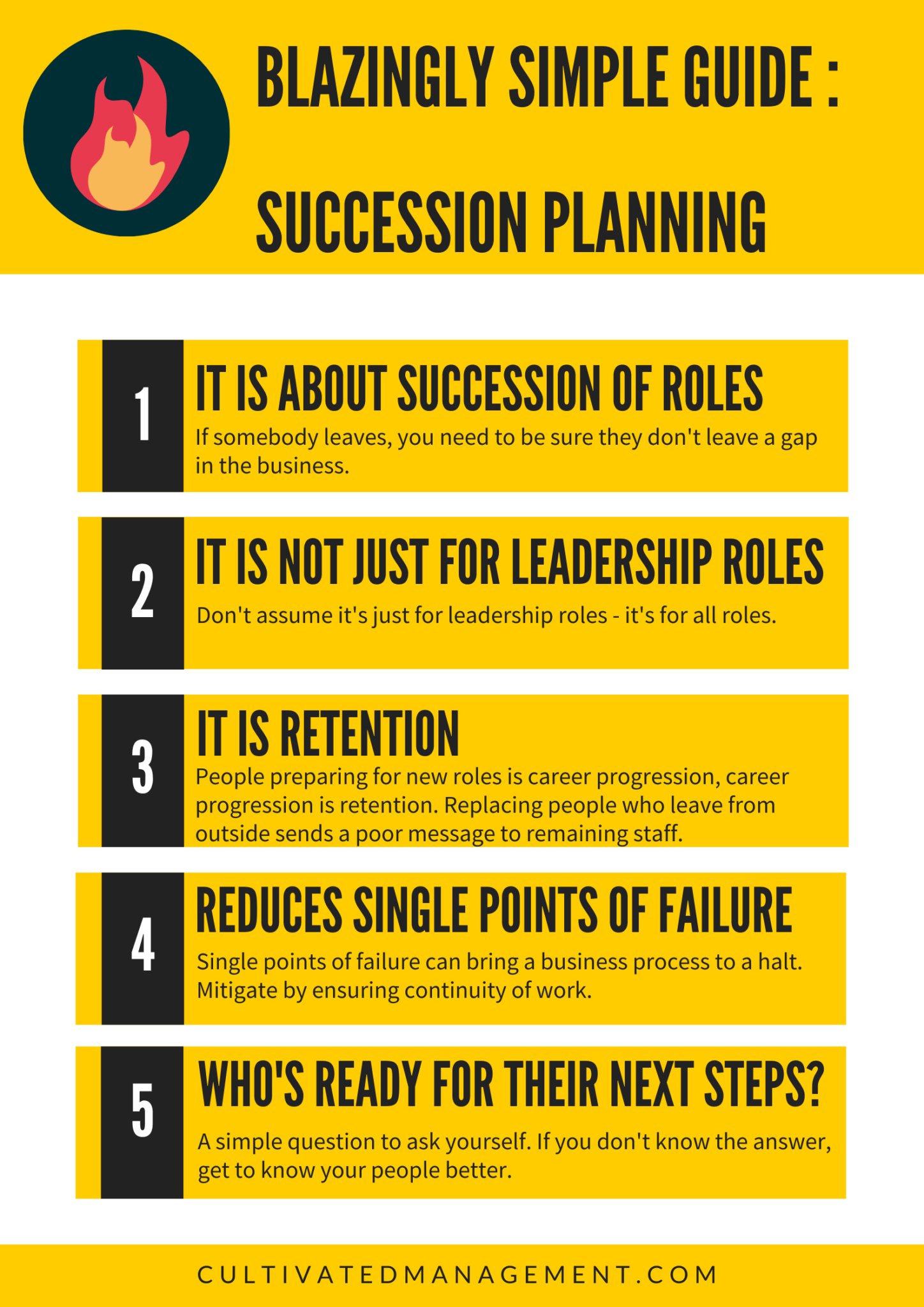
Succession planning is very simple, yet so few managers do it.
Maybe it’s because well-intentioned HR leaders, managers and consulting companies have made it sound more intimidating than it is.
It’s an essential part of being a manager, so is something I would encourage you to start doing as soon as possible.
Watch the video, and read on below.
You work for the organisation
A common mistake I see managers make, is that they believe they work for their people; those under their supervision. You do not.
You work for the organisation that employs you and pays you. As such, it’s important to consider the best outcomes for this organisation, whilst looking after those under your supervision – it’s why management is so hard.
Succession planning is all about ensuring that the business continues to operate should somebody leave.
It requires you to look at your work, the roles and the people under your supervision, and ensure that you have structured everything to add value to customers, and keep the business growing and operating should anyone leave (which they will).

1 – Succession Planning is about the succession of a role
Succession planning at a basic level is about the succession of roles in the organisation.
If somebody leaves they create a gap in this business (assuming you’ve done the hard work of building a non-bloated team).
That gap needs to be filled. It’s your job as a manager to ensure gaps are filled quickly and successfully. Ideally from inside – as we’ll cover in a minute.
There is little point in waiting for a gap to open, before considering succession planning, yet this is precisely how many managers operate. They seem bewildered and surprised that they have nobody ready to fill the gap.
They seem shocked that somebody may choose to leave the organisation (people will). They seem surprised at how much work they have left at risk, because somebody is leaving.
I’ve seen managers fail to succession plan, even when they have a three month lead time that someone is leaving. Are they burying their heads in the sand? Or simply overwhelmed with what to do next?
It’s simple. Make sure there are always people being trained and ready for the next steps in their careers – more later on this one too.
2 – Succession Planning is not just for Leadership roles
It seems common to only associate succession planning with leadership roles. I think this is too narrow. Succession planning is for all key roles.
Leaders are important, but let’s be honest, there are plenty of leaders in organisations that wouldn’t be missed if they left.
I also think much of the focus on just leadership roles comes from great leaders thinking about continuity, but not passing that thinking through the organisation to other roles.
Succession planning is for all roles that add value – which should be all of them in a good business. And let’s face it, if you have people in your team who aren’t adding value – what are you doing about that?
Therefore, it makes sense to think of succession planning for everyone in your team.
Of course, some people will be harder to replace than others, but everyone is adding value. Right?
3 – Succession Planning is retention
Many managers only consider retention strategies once someone leaves. This is nuts. Retention is an on-going activity.
If you’ve worked hard to hire good people, it makes sense to work hard to keep them. Succession planning is an aspect of retention that is easy to understand and implement. Priming people for the next steps or their next role is career progression.
Career progression is retention.
When people feel like they are going somewhere in your organisation and gaining more responsibility, and that the job is developing them, they will likely want to stay. They will know they are growing and developing. They will know they are moving toward what THEY want from their careers. This is retention.
Where that path leads to is for you and that person to discuss. It doesn’t always have to follow the classic ladder to management. In fact, many people who climb that ladder to management make a mess of it. They give management a bad name.
Some people are better suited to more technical roles, customer facing roles or more responsibility in what they currently do.
It’s the outcome of a conversation between you and them. Once you know what they want, and you’ve aligned that to what the business can offer AND what the business needs to stay alive, then this is a form of succession planning. It is retention.
In a nutshell, people moving through their careers, whilst also ensuring continuity of service/work is succession planning in action.
When people feel like they are getting somewhere in the workplace, they want to stay (of course, it has to be a good place to work also 🙂 ).
Consider succession planning one of the most effective retention initiatives you can deploy. And don’t wait for people to leave before you start it.
Another things to consider is that replacing someone with an external candidate can be quite demoralising for your remaining team. Especially so if some people in the team are ready for that next step.
Why would someone stay in your company when you simply replace people who leave with external people only?
4 – Succession Planning mitigates Single Points of Failure
When I consult with companies it takes about 2 minutes before we discover a single point of failure. Most managers focus on tech, servers, processes, machines and IT services. But the majority of single points of failure, in my experience, are people.
- Those people who are the only ones who do X work.
- Or they are the only ones who know how Y works.
- Or they are the only ones who have been delegated responsibility for Z.
When these people leave, they can leave a huge gap in process, knowledge and experience.
It’s why I ALWAYS pair people on every initiative, so that if one person leaves I have a succession plan. If both people leave, well, I suspect I have bigger issues to solve.
Both people don’t have to know everything to the same degree of knowledge and experience, but I make sure that work continues to flow should they leave, or be off sick, or decide one day just to not turn up.
I would encourage you to look for people who are blockers, single points of failure and the “go to” person (or hero), and then look at who’s ready to take on some of that work too.
If people are worried about losing their “grip” or “control” or “power”, then even more reason to counter against them as a single point of failure. Cooperation is how great work gets done, and as a manager, you can force a lot of that through the structure of work, feedback about behaviours and ensuring shared goals.
I see many managers held ransom by specialists refusing to share their domain, therefore creating a continuity problem for the business.
5 – Who’s ready for their next steps?
The best way to understand whether you have a good succession plan in place, is to ask yourself this question.
Who’s ready for their next steps?
And if you cannot answer this question, then the chances are you don’t know your team well enough. You don’t know their career aspirations, their strengths, their weaknesses and their season of life. It’s likely you may not know the process, or flow of work and where those single points of failure are.
Piecing the two together is the key to continuity and of course, retention. What gaps may we have if someone leaves, and who has the right behaviours to fill that gap?
Our businesses would be a wonderful place if people simply came together and worked through this topic on their own, but they don’t. It requires a systemic view of work and a deep understanding of what people want. And that, is in the domain of management.
Conclusion
It isn’t that hard to do succession planning. In fact, it’s Blazingly Simple.
Just grab a sheet of paper. Draw a line down the middle. On one side list the single points of failure and potential gaps you don’t have covered. On the other side write the names of everyone ready for more responsibility, or the next steps in their career.
And if either side is looking devoid of content, it may be worth doing further study.
Succession planning is an on-going process. People continue to develop and grow their experience. People will solve new problems and learn new things everyday. Ensuring the continuity of the business as it changes, is an important activity for managers. Succession planning is how to do this, and it’s a great retention strategy to.
